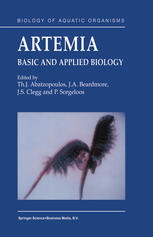

Most ebook files are in PDF format, so you can easily read them using various software such as Foxit Reader or directly on the Google Chrome browser.
Some ebook files are released by publishers in other formats such as .awz, .mobi, .epub, .fb2, etc. You may need to install specific software to read these formats on mobile/PC, such as Calibre.
Please read the tutorial at this link: https://ebookbell.com/faq
We offer FREE conversion to the popular formats you request; however, this may take some time. Therefore, right after payment, please email us, and we will try to provide the service as quickly as possible.
For some exceptional file formats or broken links (if any), please refrain from opening any disputes. Instead, email us first, and we will try to assist within a maximum of 6 hours.
EbookBell Team

4.3
38 reviewsThe objectives of this volume are to present an up-to-date (literature survey up to 2001) account of the biology of Artemia focusing particularly upon the major advances in knowledge and understanding achieved in the last fifteen or so years and emphasising the operational and functional linkage between the biological phenomena described and the ability of this unusual animal to thrive in extreme environments. Artemia is a genus of anostracan crustaceans, popularly known as brine shrimps. These animals are inhabitants of saline environments which are too extreme for the many species which readily predate them if opportunity offers. They are, thus, effectively inhabitants of extreme (hypersaline) habitats, but at the same time are able to tolerate physiologically large changes in salinity, ionic composition, temperature and oxygen tension. Brine shrimp are gener ally thought of as tropical and subtropical, but are also found in regions where temperatures are very low for substantial periods such as Tibet, Siberia and the Atacama desert. They have, thus, great powers of adaptation and are of interest for this capacity alone. The earliest scientific reference to brine shrimp is in 1756, when Schlosser reported their existence in the saltpans of Lymington, England. These saltpans no longer exist and brine shrimp are not found in Britain today. Later, Linnaeus named the brine shrimp Cancer salinus and later still, Leach used the name Artemia salina. The strong effect which the salinity of the medium exerts on the morphological development of Artemia is now widely recognised.